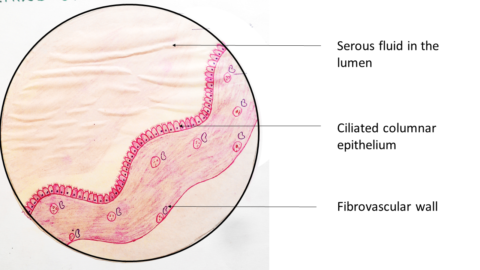Q: What are the Main Types of Ovarian Tumors?
A: Ovarian tumors are categorized into several types: surface epithelial-stromal tumors, germ cell tumors, sex cord-stromal tumors, metastatic tumors, and miscellaneous tumors.
Q:Define Teratoma
A: Teratomas are germ cell tumors that differentiate into embryonic structures.
They’re named after the Greek words ‘teras’ (monster) and ‘oma’ (tumor), as they can contain a bizarre mix of components like teeth and hair. Teratomas consist of mature or immature cells or tissues from more than one germ layer.
Q: How are Teratomas Classified?
A: Teratomas are classified into three main types:
Mature Teratomas: These are benign, cystic, and often lined by squamous epithelium.
Immature Teratomas: These contain embryonal or immature fetal tissues and are malignant.
Specialized Teratomas: Rare types that include Struma Ovarii, Carcinoid, and Strumal Carcinoid.
Q: What are the Features of Mature Teratomas?
A: Mature teratomas are usually found in young women and can be incidental findings. They might cause abdominal pain. Rarely, they can lead to paraneoplastic limbic encephalitis, an acute mental or behavioral change due to an immune reaction against brain tissue within the teratoma.
Q: Describe the morphology of Mature Teratomas?
A:Gross: these are usually unilocular tumors, cystic with smooth surface. On cut section, they contain cheesy/pultaceous material with variable amount of hairs. Areas of round nodular structure can be seen which protrudes into the lumen. These are called Rokitansky protuberance. They may be covered with hair. Rarely tooth and areas of calcification can be seen.
Microscopy: shows evidence of structures derived from the various germ cell layers. The cyst wall is usually stratified squamous epithelium with appendages like hair follicles and sebaceous glands. Derivatives of ectoderm, endoderm and mesoderm are seen in varying proportions as seen in the illustration above and below!


Q: Can Mature Teratomas Undergo Malignant Transformation?
A: Yes, although rare (about 1% of cases), mature teratomas can transform malignantly, usually into squamous cell carcinoma, thyroid carcinoma, or melanoma.
Q: What are Immature Teratomas?
A: Immature teratomas are more aggressive and often found in younger women. They contain immature tissues from the ectoderm, mesoderm, or endoderm. Grading of these teratomas is based on the amount of immature neuroepithelial tissue present, which determines their prognosis and treatment.
Q: How is the Grading of Immature Teratomas Determined?
A:
The grading of immature teratomas is a crucial aspect, as it significantly impacts prognosis and treatment strategies. This grading is based on the extent of immature neuroepithelial tissue present in the tumor.
Here’s how they are graded:
Grade 1 (Low Grade): Immature neuroepithelium is present in small foci, occupying less than one low-power field in any slide. These tumors typically have a better prognosis.
Grade 2 (Intermediate Grade): Here, immature neuroepithelium is found in one to three low-power fields in any slide. This indicates a greater presence of immature tissue compared to Grade 1.
Grade 3 (High Grade): This grade is assigned when immature neuroepithelium is present in more than three low-power fields in any slide. High-grade tumors indicate a significant amount of immature tissue and typically have a worse prognosis.
It’s important to note that the presence of immature neuroepithelium, especially in significant amounts, is what classifies these tumors as malignant. The higher the grade, the more aggressive the treatment approach, often involving chemotherapy, might be required.
Q: How are Specialized Teratomas different?
A: Specialized teratomas, like Struma Ovarii, Carcinoid, and Strumal Carcinoid, are composed of one specific type of mature tissue. For example, Struma Ovarii contains thyroid tissue and can cause hyperthyroidism, while Carcinoid tumors, arising from intestinal tissue, may produce serotonin, leading to carcinoid syndrome.
Q: What is the Prognosis and Treatment for Teratomas?
A: The prognosis and treatment depend on the type and grade of the teratoma. Mature teratomas generally have a good prognosis and might only need surgical removal. Immature teratomas, especially high-grade ones, may require aggressive treatment, including chemotherapy.











Recent Comments